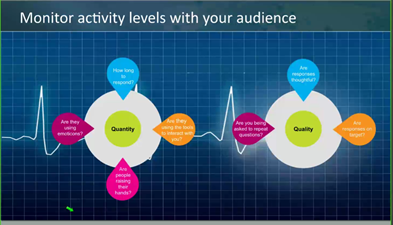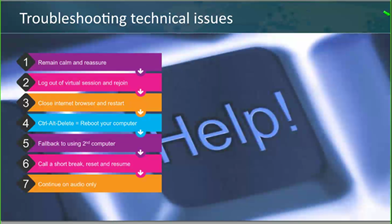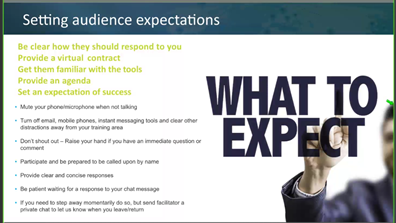For virtual events in the past, strong content was good enough to guarantee its success. However, that is no longer the case.
Virtual is the norm rather than the exception, and virtual experiences need to be delivered at the highest level or risk getting lost in the crowd. The time is now, to go from good to great.

Virtual working expert and founder of DS Virtually, David Smith started his virtual journey in 2008 and has worked on most virtual platforms in the market since then. In a recent webinar sponsored by Training Magazine Network and Adobe Connect, he spoke of his passion for delivering high-quality virtual experiences. He also shared easily adoptable ways to take your virtual experience delivery to new heights and why Adobe Connect has been his platform of choice for the last 7 to 8 years of his career.
David outlines 3 key pillars for exceptional virtual events delivery: Virtual Toolset, Virtual Skillset and Virtual Mindset
Collectively, these constitute a 3-legged stool on which your virtual experiences rest. All three legs should function individually and collectively to ensure smooth and effective virtual experiences. Let’s elaborate on each leg.
Virtual Toolset:

The importance of acquiring the ability to use the tools that your virtual platform provides can’t be stressed enough. Even a handful of tools can help create stunning virtual experiences if you have the skillset to use them well, just the way even a hundred different engagement tools won’t help without the right skills to use them.
With the right tools at disposal, you can make each event a unique unforgettable experience, even if it is with a simple change in the delivery structure of a classroom or event background. However, having the right set of tools is only half the job done. The rest hinges on being able to use those tools effectively. Here is a list of things to ensure a seamless virtual experience:

- Understanding the tools is vital as it would not matter how advanced the toolset is if you’re unable to use them in the right circumstances.
- Setting up your tools, equipment and backgrounds as per the objectives & scale of a particular event can make the difference between a hectic event and a great one. This includes ensuring that your audiences have stable internet connections and are prepared to minimize strain on their bandwidth during the event.
- Checking to ensure that everyone has updated their systems and software to the latest versions is often the quickest fix to most issues that are likely to crop up mid-event.
- Ensuring both presenters and attendees pick a wired connection over Wi-Fi to ensure a smooth and consistent connection.
- Using USB headsets that support virtual experiences better than standard wired and Bluetooth headsets. USB headsets are designed to better support virtual conferences and events while most wired headsets only support audio out!
- Sticking to the desktop version of applications as much as possible since the mobile experience is usually a limited version of the desktop application.
But whatever tool or accessory you use, the important thing is for the facilitator to test it out well in advance to avoid surprises. Well tested is well prepared.
Virtual Mindset:

- The ability to work from anywhere sounds like a dream. However, in reality, it can pose several challenges that can lead to inconsistent virtual experiences. Availability of reliable internet and quiet spaces to present from are the top two issues that crop up while working from anywhere.
- Minimizing distractions, both for presenters as well as the audience. Reduce the distractions that often come bundled with working from home and your audience will thank you for it.
- Letting everyone manage their own audio might seem like asking for trouble, but it sets the tone for an engaging session where the audience is more likely to behave responsibly.
- While the human eye is built to respond to motion, it is important to keep animations and other moving elements minimal as too much can be distracting and reduce bandwidth.
- Virtual fatigue is real and so are its dangers. Virtual presenters should take the responsibility to ensure that video is not overused.
- Every additional link or app that is running simultaneously to the virtual session can be a bandwidth bandit. Inform participants that it is their responsibility to ensure that they are not being slowed down.
- Additional barriers such as firewalls and VPNs need to be managed prudently to ensure a smooth and high-quality virtual experience that keeps your audience coming back for more.
Virtual Skillset:
- An example of a simple skill that can make or break a virtual session is video. A simple way to evaluate webcam usage is by adhering to DABL rule.




- The ability to monitor the quality and quantity of activity levels of a virtual audience is a key skill to ensure that the presenter is able to judge and adapt to the audience’s expectations. This skill helps presenters use the right tools at the right time, instead of using them just for the sake of it.

- A big part of the skills needed to become an effective virtual trainer is troubleshooting technical issues. This can mean anything from knowing who to call at the right time to actually being able to sort out some issues.

- The ability to set the right audience expectations is another skill that many master virtual facilitators have spoken about and is still one of the most important aspects to virtual experience success.

The final key thought to leave you with – while we should always be aiming to go from good to great, do not belittle ‘good’. With an adequate focus on the basics of virtual presentation along with strong content, you will automatically move from good to great.
Even though I have tried doing justice to the thoughts put forth by David Smith, I would highly recommend watching the comprehensive recording of his webinar to anyone who is serious about leveling up their virtual presentation game.
Adobe Connect is a leading webinar & virtual training solution designed to be a single platform to plan, deliver, and track highly engaging webinars. Visit https://www.adobe.com/products/adobeconnect/webinars.html for a 30-day free trial or visit www.connectusers.com for more pro tips on designing and elevating audience engagement.
